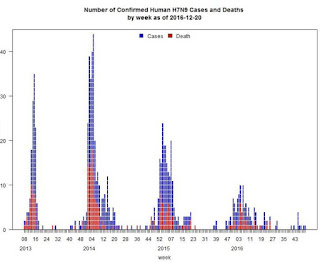#12,054
Although dated Dec 19th, the WHO's Influenza at the Human-Animal Interface, monthly risk assessment summary, was only posted in the past 48 hours. The report details 11 novel flu infections (9 avian, 2 swine variant) reported since November 22nd, including 1 H5N6 infection, 8 H7N9 infections, 1 H1N2v infection, and 1 H3N2v infection.
All of these, except for the H3N2v case, have been previously reported in this blog and by various news organizations.
The uptick in avian flu cases over the past month are not unexpected, as the winter is prime time for the spread of both seasonal and novel flu viruses.
Some excerpts below, but follow the link to read the report in its entirety.
Influenza at the human-animal interface
Summary and assessment, 22 November to 19 December 2016
- New infections1: Since the previous update, new human infections with influenza A(H5N6), A(H7N9), A(H1N2)v and A(H3N2)v viruses were reported.
- Risk assessment: The overall public health risk from currently known influenza viruses at the human-animal interface has not changed, and the likelihood of sustained human-to-human transmission of these viruses remains low. Further human infections with viruses of animal origin is expected.
- IHR compliance: All human infections caused by a new influenza subtype are required to be reported under the International Health Regulations (IHR, 2005).2 This includes any animal and non-circulating seasonal viruses. Information from these notifications will continue to inform risk assessments for influenza at the human-animal interface.
The one new report comes from Canada, where a patient was hospitalized with a swine variant H3N2v viral infection.
Influenza A(H3N2)v viruses
On 16 December 2016, WHO was notified of a confirmed human case of influenza A(H3N2) variant virus in Canada. The case developed respiratory infection symptoms on 24 October 2016, was hospitalized on 8 November 2016 with the diagnosis of pneumonia, and has recovered. The case has confirmed exposure to ill swine on a farm. Animal health and epidemiological investigations are ongoing. Partial sequence analysis of all 8 gene segments of the virus isolated from the case indicates they are closely related to influenza A(H3N2) swine influenza viruses currently circulating in swine in North America.
This is the first human case of A/Indiana/08/2011-like H3N2v influenza virus infection reported to WHO from Canada. Human infection with influenza A(H3N2)v viruses detected elsewhere have typically resulted in mild disease, although some have been hospitalized and at least one A(H3N2)v-associated death has been reported.
Risk Assessment:
1. What is the likelihood that additional human cases of infection with swine influenza viruses will occur?
Influenza A(H1N2) and A(H3N2) viruses circulate in swine populations in many regions of the world. Depending on geographic location, the genetic characteristics of these viruses differ. Most human cases are exposed to the swine influenza viruses through contact with infected swine or contaminated environments. Human infection tends to result in mild clinical illness, although some cases have been hospitalized with more severe disease and one fatal case has been reported. Since these viruses continue to be detected in swine populations, further human cases can be expected.
2. What is the likelihood of human-to-human transmission of swine influenza viruses?
No case clusters have been reported. Current evidence suggests that these viruses have not acquired the ability of sustained transmission among humans, thus the likelihood is low.
